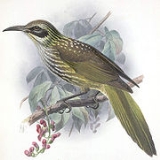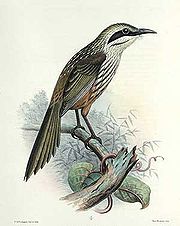
Kioea
Encyclopedia
The Kioea was a Hawaii
an bird
that became extinct
around 1859. The kioea was in decline even before the discovery of Hawaii by Europeans. Even native Hawaiians are seemingly unfamiliar with this bird. The feather
s of the kioea were not used in Hawaiian featherwork, nor is it mentioned in any chants or legend
s. Only four specimens exist in museums.
The cause of its extinction is unknown.
 The kioea was a large bird, about 13 inches (33 cm) long, with a long, slightly curved bill
The kioea was a large bird, about 13 inches (33 cm) long, with a long, slightly curved bill
. What distinguished the kioea from other honeyeaters was the broad black stripe on its face and bristle-like feathers on the head and breast. The Hawaiian
word "kioea" literally means "stand tall".
Although all four known specimens are from the island of Hawaii
, fossil
records show that related birds existed on other Hawaiian islands
as well.
Until recently, this species and the birds in the genus Moho
were thought to belong to the family Meliphagidae (honeyeater
s) because they looked and acted so similar to members of that family, including many morphological
details. A 2008 study argued, on the basis of a phylogenetic
analysis of DNA
from museum specimens, that the genera Moho and Chaetoptila do not belong to the Meliphagidae but instead belong to a group that includes the waxwing
s and the Palmchat
; they appear especially close to the silky-flycatcher
s. The authors proposed a family, Mohoidae
, for these two extinct genera.
Hawaii
Hawaii is the newest of the 50 U.S. states , and is the only U.S. state made up entirely of islands. It is the northernmost island group in Polynesia, occupying most of an archipelago in the central Pacific Ocean, southwest of the continental United States, southeast of Japan, and northeast of...
an bird
Bird
Birds are feathered, winged, bipedal, endothermic , egg-laying, vertebrate animals. Around 10,000 living species and 188 families makes them the most speciose class of tetrapod vertebrates. They inhabit ecosystems across the globe, from the Arctic to the Antarctic. Extant birds range in size from...
that became extinct
Extinction
In biology and ecology, extinction is the end of an organism or of a group of organisms , normally a species. The moment of extinction is generally considered to be the death of the last individual of the species, although the capacity to breed and recover may have been lost before this point...
around 1859. The kioea was in decline even before the discovery of Hawaii by Europeans. Even native Hawaiians are seemingly unfamiliar with this bird. The feather
Feather
Feathers are one of the epidermal growths that form the distinctive outer covering, or plumage, on birds and some non-avian theropod dinosaurs. They are considered the most complex integumentary structures found in vertebrates, and indeed a premier example of a complex evolutionary novelty. They...
s of the kioea were not used in Hawaiian featherwork, nor is it mentioned in any chants or legend
Legend
A legend is a narrative of human actions that are perceived both by teller and listeners to take place within human history and to possess certain qualities that give the tale verisimilitude...
s. Only four specimens exist in museums.
The cause of its extinction is unknown.

Beak
The beak, bill or rostrum is an external anatomical structure of birds which is used for eating and for grooming, manipulating objects, killing prey, fighting, probing for food, courtship and feeding young...
. What distinguished the kioea from other honeyeaters was the broad black stripe on its face and bristle-like feathers on the head and breast. The Hawaiian
Hawaiian language
The Hawaiian language is a Polynesian language that takes its name from Hawaii, the largest island in the tropical North Pacific archipelago where it developed. Hawaiian, along with English, is an official language of the state of Hawaii...
word "kioea" literally means "stand tall".
Although all four known specimens are from the island of Hawaii
Hawaii (island)
The Island of Hawaii, also called the Big Island or Hawaii Island , is a volcanic island in the North Pacific Ocean...
, fossil
Fossil
Fossils are the preserved remains or traces of animals , plants, and other organisms from the remote past...
records show that related birds existed on other Hawaiian islands
Hawaiian Islands
The Hawaiian Islands are an archipelago of eight major islands, several atolls, numerous smaller islets, and undersea seamounts in the North Pacific Ocean, extending some 1,500 miles from the island of Hawaii in the south to northernmost Kure Atoll...
as well.
Until recently, this species and the birds in the genus Moho
Moho (genus)
Moho is a genus of extinct birds in the Hawaiian bird family, Mohoidae, that were endemic to the Hawaiian Islands. Members of the genus are known as Ōō in the Hawaiian language. Their plumage was generally striking glossy black; some species had yellowish axillary tufts and other black outer...
were thought to belong to the family Meliphagidae (honeyeater
Honeyeater
The honeyeaters are a large and diverse family of small to medium sized birds most common in Australia and New Guinea, but also found in New Zealand, the Pacific islands as far east as Samoa and Tonga, and the islands to the north and west of New Guinea known as Wallacea...
s) because they looked and acted so similar to members of that family, including many morphological
Morphology (biology)
In biology, morphology is a branch of bioscience dealing with the study of the form and structure of organisms and their specific structural features....
details. A 2008 study argued, on the basis of a phylogenetic
Phylogenetics
In biology, phylogenetics is the study of evolutionary relatedness among groups of organisms , which is discovered through molecular sequencing data and morphological data matrices...
analysis of DNA
DNA
Deoxyribonucleic acid is a nucleic acid that contains the genetic instructions used in the development and functioning of all known living organisms . The DNA segments that carry this genetic information are called genes, but other DNA sequences have structural purposes, or are involved in...
from museum specimens, that the genera Moho and Chaetoptila do not belong to the Meliphagidae but instead belong to a group that includes the waxwing
Waxwing
The waxwings form the genus Bombycilla of passerine birds. According to most authorities, this is the only genus placed in the family Bombycillidae.-Description:Waxwings are characterised by soft silky plumage...
s and the Palmchat
Palmchat
The Palmchat is a small, long-tailed passerine bird, the only species in the genus Dulus and the family Dulidae. It is thought to be related to the waxwings, family Bombycillidae, and is sometimes classified with that group...
; they appear especially close to the silky-flycatcher
Silky-flycatcher
The silky-flycatchers are a small family, Ptilogonatidae , of passerine birds. The family contains only four species in three genera. They were formerly lumped with waxwings and Hypocolius in the family Bombycillidae, and they are listed in that family by the Sibley-Monroe checklist...
s. The authors proposed a family, Mohoidae
Mohoidae
Mohoidae is a family of Hawaiian species of recently extinct, nectarivorous songbirds in the genera Moho and Chaetoptila . These now extinct birds form their own family, representing the only complete extinction of an entire avian family in modern times, when the disputed family Turnagridae is...
, for these two extinct genera.

